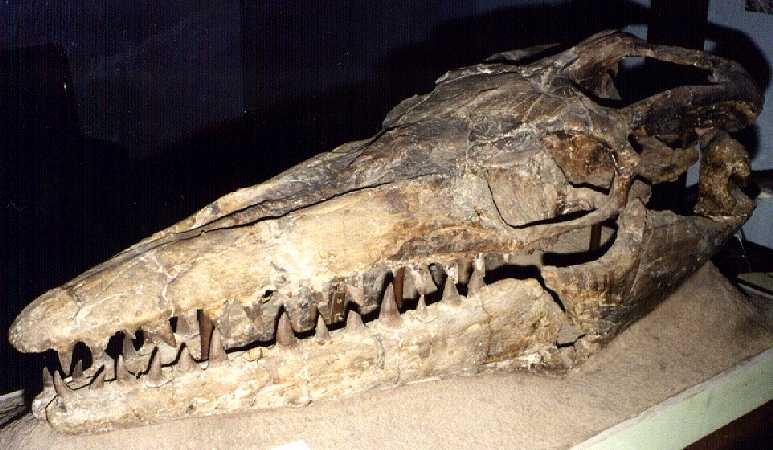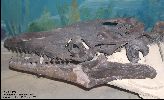Click on the Thumbnail |
Specimen Description |
Specimen Number / I.D. |
 |
Mosasaurus missouriensis
(horridus Williston), lateral view of the right side of a complete skull,
Pierre Shale, South Dakota. This skull is about one meter (39 inches) long |
The University of Kansas, KUVP 1034, Museum of Natural History |
 |
Mosasaurus missouriensis (horridus Williston), lateral
view of the left side of a complete skull, Pierre Shale, South Dakota. Originally a new
species named by Williston, the name was later changed. |
The University of Kansas, Museum of Natural History, KUVP 1034 |
 |
Mosasaurus missouriensis (horridus Williston), dorsal
-lateral view of the left rear quadrant of a complete skull, Pierre Shale, South Dakota |
The University of Kansas, Museum of Natural History, KUVP 1034 |
 |
Mosasaurus missouriensis (horridus Williston), dorsal
-lateral view of the left rear quadrant of a complete skull, Pierre Shale, South
Dakota. Note location of quadrate connecting jaw to skull. |
The University of Kansas, Museum of Natural History |
 |
Mosasaurus missouriensis (horridus Williston),
view of the back of a complete skull, Pierre Shale, South Dakota. Large oval bone at
center of picture is the right quadrate. |
The University of Kansas, Museum of Natural History |
 |
Mosasaurus sp., lateral view of the right side of the
skull. Bear Paw Shale Fm., Montana. The story of the discovery and collecting
of this specimen is told in John Horner's book, Living with Dinosaurs |
Museum of the Rockies,
Montana State University, Bozeman, Montana
MOR-006 |
 |
Left side of skull. "Large mosasaur with both
scapula-coracoids, several cervical and dorsal vertebrae, including entire atlas-axis
complex, several ribs, one or two paddles, interclavicle, both pubes and complete
skull" |
Photo used with permission, Museum of the Rockies, Montana State University,
Bozeman, MT. Do not copy without permission. |
 |
Back of skull of MOR-006, showing large openings that enclosed the
large muscles that closed the lower jaw. |
Photo used with permission, Museum of the Rockies, Montana State University,
Bozeman, MT. Do not copy without permission. |
 |
Front limb of MOR-006. Based on the shapes of various bones
in this paddle, it is most likely that this specimen is a Mosasaurus conodon. |
Photo used with permission, Museum
of the Rockies, Montana State University, Bozeman, MT. Do not copy without
permission. |
 |
A reconstruction of a thirty foot long Mosasaurus conodon
(SDSMT-452) skeleton from the Pierre Shale of South Dakota, approximately 75 million years
old. |
The Museum of Geology at the South Dakota
School of Mines and Technology, Rapid City, South Dakota |
 |
A closer view of the left side of the skull of SDSMT-452. To
see more pictures of this specimen, CLICK HERE. |
The Museum of Geology at the South Dakota
School of Mines and Technology, Rapid City, South Dakota |
 |
Globidens dakotensis, ventral view of skull showing
unusual round teeth, Pierre Shale, South Dakota |
The Field Museum of Natural
History, Chicago, Illinois |
 |
Globidens sp. lateral view of right dentary, from the
Pierre Shale of Kansas. This specimen is featured on the Globidens
webpage. Click here for a drawing of Globidens
by Russell Hawley. |
FHSM VP 13828; Sternberg
Museum of Natural History, Hays, KS. |
 |
Globidens sp. lateral view of the anterior portion of the
right dentary, from the Pierre Shale of Kansas. This specimen is featured on the Globidens webpage. |
FHSM VP 13828; Sternberg
Museum of Natural History, Hays, KS. |
 |
A fragment of the upper jaw of an unidentified mosasaur from the
Saratoga chalk of southwestern Arkansas (near Columbus, AR). |
This photograph was provided courtesy of the Arkansas State University Museum at Jonesboro,
Arkansas |
 |
A close-up of two of the remaining teeth. At the time,
southwestern Arkansas was ocean front property along the Gulf Coast of eastern North
America. |
This photograph was provided courtesy of the Arkansas State University Museum at Jonesboro,
Arkansas |
 |
Four views of a single dorsal vertebra from the Arkansas
specimen. In mosasaurs, the rounded end of the vertebrae point away from the head. |
This photograph was provided courtesy of the Arkansas State University Museum at Jonesboro,
Arkansas |
 |
Five of the vertebrae from the Arkansas specimen. Although
there is little diagnostic material available, these bones probably came from a Mosasaurus
or Plioplatecarpus. |
This photograph was provided courtesy of the Arkansas State University Museum at Jonesboro,
Arkansas |
 |
Ventral view of a Prognathodon overtoni skull
(SDSMT- 3393) from the Pierre Shale of South Dakota. Note the two extra rows of teeth
on the roof of the mouth (pterygoid bones). See a web page about
this specimen here. |
The Museum
of Geology at the South Dakota School of Mines and Technology, Rapid City. South
Dakota |
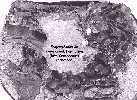 |
This photo (courtesy of Lynn Harrell, Jr.) shows the remains of a Prognathodon
sp. from the Coon Creek Member of the Ripley Formation (late Cretaceous in western
Tennessee. This specimen was found in 1989, and identified by Gordon Bell. |
Pink Palace
Museum, Memphis, Tennessee. See also the Coon Creek Science Center. |
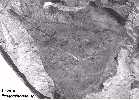 |
A close-up of the frontal of the Tennessee Prognathodon sp.
specimen. The Coon Creek formation was deposited in a shallow, near-shore environment as a
part of the Mississippian Embayment during late Cretaceous time. (Photo courtesy of Lynn
Harrell, Jr.) |
Pink Palace
Museum, Memphis, Tennessee. See also the Coon Creek Science Center. |
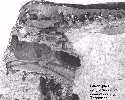 |
The lower jaws of Prognathodon sp. Compare these with the
lower jaws of a similar specimen from the Pierre Shale of South
Dakota. (Photo courtesy of Lynn Harrell, Jr.) |
Pink Palace
Museum, Memphis, Tennessee. See also the Coon Creek Science Center. |
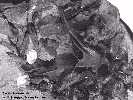 |
This jumble of bones in includes parts of the mosasaur's skull and
vertebrae. The two white objects are clam shells, which are preserved in great
abundance in the Coon Creek member of the Ripley Formation. (Photo courtesy of Lynn
Harrell, Jr.) |
Pink Palace
Museum, Memphis, Tennessee. See also the Coon Creek Science Center. |
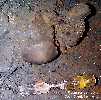 |
This is a picture of a large mosasaur vertebra as found in the
Coon Creek Formation at the Coon Creek Science Center. The vertebrae is a part of a
recently discovered set of mosasaur remains. (Photo courtesy of Vicky Goodrum). |
Pink Palace
Museum, Memphis, Tennessee. See also the Coon Creek Science Center. |
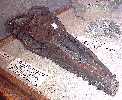 |
A cast of the skull of Plotosaurus bennisoni, an
unusual mosasaur from California. The original specimen (UC V3718 / 32778) is at the
University of California. |
Natural History
Museum, Sierra College, Rocklin CA. |
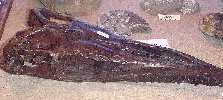 |
A side view of the skull ... notice the large opening for the
eye. This is somewhat larger than most other mosasaurs. |
Natural History
Museum, Sierra College, Rocklin CA. |
 |
A top view of the front of the skull. |
Natural History
Museum, Sierra College, Rocklin CA. |
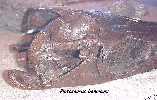 |
A lateral view of the rear, right side of the skull. |
Natural History
Museum, Sierra College, Rocklin CA. |
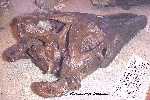 |
A view of the back of the skull showing the occipital condyle
where the atlas-axis vertebra is attached. |
Natural History
Museum, Sierra College, Rocklin CA. |
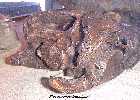 |
A closer look at the back of the skull. A
figure adapted from Camp (1942) of the complete skeleton of UC V3718 / 32778 is shown HERE. |
Natural History
Museum, Sierra College, Rocklin CA. |
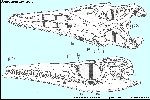 |
LEFT: A drawing of the skull of Plotosaurus
bennisoni (Camp) in dorsal and left lateral view, adapted from Piveteau, J. (Ed.) (1952-1969). Traité de Paléontologie,
Tome V. (Scan provided by Amin Khaleghparast, July, 2012).
RIGHT:
The original figure by Camp (1942,
fig. 1) |
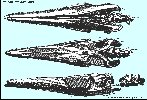 |
